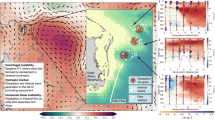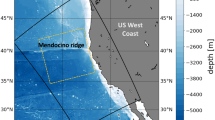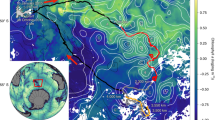Abstract
Ocean eddies generated through instability of the mean flow are a vital component of the energy budget of the global ocean1,2,3. In equilibrium, the sources and sinks of eddy energy have to be balanced. However, where and how eddy energy is removed remains uncertain3,4. Ocean eddies are observed to propagate westwards at speeds similar to the phase speeds of classical Rossby waves5, but what happens to the eddies when they encounter the western boundary is unclear. Here we use a simple reduced-gravity model along with satellite altimetry data to show that the western boundary acts as a ‘graveyard’ for the westward-propagating ocean eddies. We estimate a convergence of eddy energy near the western boundary of approximately 0.1–0.3 TW, poleward of 10° in latitude. This energy is most probably scattered into high-wavenumber vertical modes, resulting in energy dissipation and diapycnal mixing6. If confirmed, this eddy-energy sink will have important implications for the ocean circulation.
This is a preview of subscription content, access via your institution
Access options
Subscribe to this journal
Receive 12 print issues and online access
$259.00 per year
only $21.58 per issue
Buy this article
- Purchase on Springer Link
- Instant access to full article PDF
Prices may be subject to local taxes which are calculated during checkout



Similar content being viewed by others
References
Gill, A. E., Green, J. S. A. & Simmons, A. J. Energy partition in the large-scale ocean circulation and the production of mid-ocean eddies. Deep-Sea Res. 21, 499–528 (1974).
Smith, K. S. Eddy amplitudes in baroclinic turbulence driven by nonzonal mean flow: Shear dispersion of potential vorticity. J. Phys. Oceanogr. 37, 1037–1050 (2007).
Ferrari, R. & Wunsch, C. Ocean circulation kinetic energy: Reservoirs, sources, and sinks. Annu. Rev. Fluid Mech. 41, 253–282 (2009).
Wunsch, C. & Ferrari, R. Vertical mixing, energy, and the general circulation of the oceans. Annu. Rev. Fluid Mech. 36, 281–314 (2004).
Chelton, D. B., Schlax, M. G., Samelson, R. M. & de Szoeke, R. A. Global observations of large oceanic eddies. Geophys. Res. Lett. 34, L15606 (2007).
Dewar, W. K. & Hogg, A. M. Topographic inviscid dissipation of balanced flow. Ocean Modelling 32, 1–13 (2010).
Sen, A., Scott, R. B. & Arbic, B. K. Global energy dissipation rate of deep-ocean low-frequency flows by quadratic bottom boundary layer drag: Computations from current-meter data. Geophys. Res. Lett. 35, L09606 (2008).
Duhaut, T. H. & Straub, D. N. Wind stress dependence on ocean surface velocity: Implications for mechanical energy input to ocean circulation. J. Phys. Oceanogr. 36, 202–211 (2006).
Zhai, X. & Greatbatch, R. J. Wind work in a model of the northwest Atlantic Ocean. Geophys. Res. Lett. 34, L04606 (2007).
Hughes, C. W. & Wilson, C. Wind work on the geostrophic ocean circulation, including effects of small scales in the wind stress. J. Geophys. Res. 113, C02016 (2008).
Xu, Y. & Scott, R. B. Subtleties in forcing eddy resolving ocean models with satellite wind data. Ocean Modelling 20, 240–251 (2008).
Scott, R. B. & Xu, Y. An update on the wind power input to the surface geostrophic flow of the world ocean. Deep-Sea Res. 56, 295–304 (2009).
Molemaker, M. J., McWilliams, J. C. & Yavneh, I. Baroclinic instability and loss of balance. J. Phys. Oceanogr. 35, 1505–1517 (2005).
Bühler, O & McIntyre, M. E. Wave capture and wave vortex duality. J. Fluid Mech. 534, 67–95 (2005).
Holloway, G. Representing topographic stress for large-scale ocean models. J. Phys. Oceanogr. 22, 1033–1046 (1992).
Adcock, S. T. & Marshall, D. P. Interactions between geostrophic eddies and the mean circulation over large-scale bottom topography. J. Phys. Oceanogr. 30, 3223–3238 (2000).
Polzin, K. & Firing, E. Estimates of diapycnal mixing using LADCP and CTD data from I8S. Int. WOCE Newslett. 29, 39–42 (1997).
Marshall, D. P. & Naveira Garabato, A. C. A conjecture on the role of bottom-enhanced diapycnal mixing in the parameterization of geostrophic eddies. J. Phys. Oceanogr. 38, 1607–1613 (2008).
Nikurashin, M. & Ferrari, R. Radiation and dissipation of internal waves generated by geostrophic motions impinging on small-scale topography: Theory. J. Phys. Oceanogr. 40, 1055–1074 (2010).
Johnson, H. L. & Marshall, D. P. A theory for the surface Atlantic response to thermohaline variability. J. Phys. Oceanogr. 32, 1121–1132 (2002).
Kanzow, T. et al. Observing basin-wide integrated volume transports in an eddy-filled ocean. J. Phys. Oceanogr. 39, 3091–3110 (2009).
Pedlosky, J. A study of the time dependent ocean circulation. J. Phys. Oceanogr. 22, 267–272 (1965).
Wunsch, C. The vertical partition of oceanic horizontal kinetic energy. J. Phys. Oceanogr. 28, 1770–1794 (1997).
Smith, K. S. & Vallis, G. K. The scales and equilibration of midocean eddies: Freely evolving flow. J. Phys. Oceanogr. 31, 554–571 (2001).
Le Traon, P. Y., Nadal, F. & Ducet, N. An improved mapping method of multisatellite altimeter data. J. Atmos. Oceanic Technol. 15, 522–534 (1998).
Gouretski, V. V. & Koltermann, K. P. WOCE Global Hydrographic Climatology. Ber. Bundesamte Seeschifffahrt Hydrogr. Rep. 35 (Bundesamt Seeschiffahrt Hydrogr., 2004).
Wunsch, C. The work done by the wind on the oceanic general circulation. J. Phys. Oceanogr. 28, 2332–2340 (1998).
Samelson, R. M. Large-scale circulation with locally enhanced vertical mixing. J. Phys. Oceanogr. 28, 712–726 (1998).
Scott, J. R. & Marotzke, J. The location of diapycnal mixing and the meridional overturning circulation. J. Phys. Oceanogr. 32, 3578–3595 (2002).
Maltrud, M. E. & McClean, J. L. An eddy resolving global 1/10° ocean simulation. Ocean Modelling 8, 31–54 (2005).
Acknowledgements
We are grateful for funding from the UK Natural Environment Research Council. H.L.J. is supported by a Royal Society University Research Fellowship and D.P.M. acknowledges additional support from the James Martin 21st Century School, University of Oxford.
Author information
Authors and Affiliations
Contributions
X.Z. conducted the numerical experiments and analysis of the altimetry data. All the authors contributed to design of the study, interpretation of the results and writing of the manuscript.
Corresponding author
Ethics declarations
Competing interests
The authors declare no competing financial interests.
Supplementary information
Supplementary Information
Supplementary Information (PDF 2294 kb)
Supplementary Information
Supplementary Information (GIF 14901 kb)
Rights and permissions
About this article
Cite this article
Zhai, X., Johnson, H. & Marshall, D. Significant sink of ocean-eddy energy near western boundaries. Nature Geosci 3, 608–612 (2010). https://doi.org/10.1038/ngeo943
Received:
Accepted:
Published:
Issue Date:
DOI: https://doi.org/10.1038/ngeo943
This article is cited by
-
Eddy activity in the Arctic Ocean projected to surge in a warming world
Nature Climate Change (2024)
-
Remote energy sources for mixing in the Indonesian Seas
Nature Communications (2022)
-
Dissipation of mesoscale eddies at a western boundary via a direct energy cascade
Scientific Reports (2022)
-
Deep learning to infer eddy heat fluxes from sea surface height patterns of mesoscale turbulence
Nature Communications (2021)
-
Geographical variation and controlling mechanism of eddy-induced vertical temperature anomalies and eddy available potential energy in the South China Sea
Ocean Dynamics (2021)



